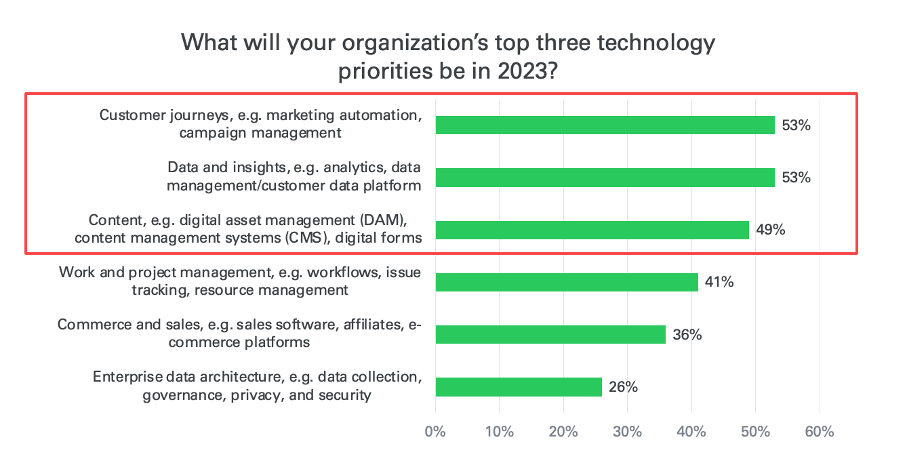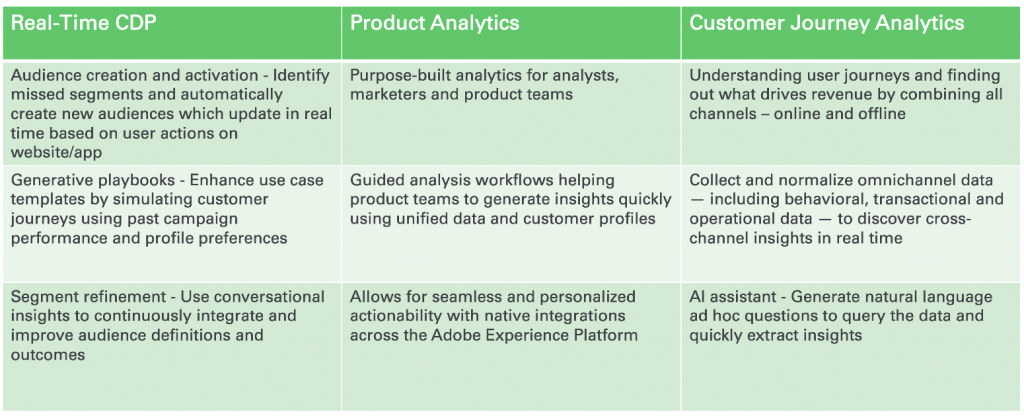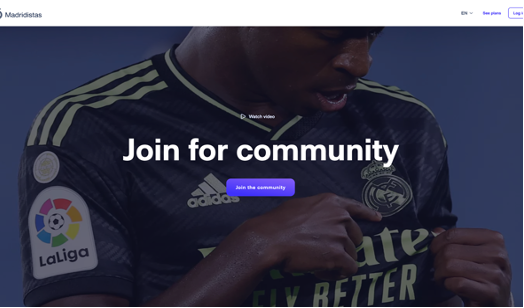FELD M @ Adobe Summit EMEA 2023 — A Summary of Insights & Trends

Table of contents
- Focus topics and tools at the Adobe Summit EMEA 2023
- How to navigate in a cookieless world: Real-Time CDP
- Ensuring data in a cookieless world by using partner data
- Personalized insights & engagement: Real Madrid use case
- GenAI: Adobe Sensei
- A party of three: insights for analysts, marketers and product teams
- Summary
Focus topics and tools at the Adobe Summit EMEA 2023
During our two days in London, the Summit featured a variety of sessions where we were able to learn a lot about other companies’ experiences and exciting use cases from different industries, as well as learn about the latest industry developments and resulting Adobe enhancements and improvements.
Not only the ever-changing customer needs, but also the constantly evolving possibilities of the technology affect the way companies adapt their strategies. Below you can see the priorities of topics for 2023 which were presented by Jim Clark in one of the sessions:

You can see that the customer journey is high on the list, and more and more companies opt for the omnichannel approach to catch up with the users at every stage of the journey. But how can Adobe Experience Platform (AEP) support businesses in creating personalized and real-time adjustable experiences? That was what everyone at the Summit was looking forward to learning more about.
Adobe’s most exciting tools in AEP:
It was obvious that Adobe sees enormous potential in AEP in general and invests a lot of effort into CDP & Customer Journey Analytics in particular. Therefore the vast majority of the sessions and talks were devoted to these tools. Below, we have summarized the most relevant innovations in CDP, APA and CJA that were presented at the Summit:

-
Real-time insights creation and activation — especially in the cookieless world
-
Personalization
-
Fast actions and insights generation with AI (Adobe Sensei)
Let’s go a bit deeper into each of these topics.
How to navigate in a cookieless world: Real-Time CDP
One question that companies have been asking for a few years now, but which is becoming more and more pertinent with Google’s announcement of cookie deprecation in 2024 is: how can we secure our data in a cookieless future?
There are also many answers to this question and, above all, many technical possibilities. Adobe presented the challenges and a few solutions:

Ensuring data in a cookieless world by using partner data
Unlock full-funnel marketing:
-
Enrich first-party audiences with data partners: find new customers with additional attributes and known customer IDs from trusted partners, e.g.:

-
Find your customers where they are with new activation partners: activate audiences in an expanded set of destinations and channels, e.g.:
 >
>
Personalized insights & engagement: Real Madrid use case
One of the sessions was devoted to a solution developed by Real Madrid, which involved creating a worldwide community platform to bring together fans, provide exclusive content and discounts, early access to tickets and much more to create an outstanding fan experience and, above all, to strengthen fan loyalty.
That’s why they founded the community platform “Madridistas”, for which they rely on many Adobe products to personalize the community experience within the app and web and engage fans via a real-time CDP.

Real Madrid created a fully connected ecosystem with the fan at the center to offer personalized experiences by using all relevant technologies to create user profiles:
-
The CDP collects all user behavior such as clicks, scroll behavior, etc. to create user profiles that are continuously updated. Inside the CDP, all the different data sources are combined together.
-
Adobe Journey Optimizer which boosts engagement across any journey
-
Adobe Customer Journey Analytics is being used to gather omnichannel insights and analysis
-
Adobe Product Analytics with a new set of purpose-built analysis
-
Audience portal which would include all different audiences based on automatic Sensei Gen AI. By just typing in your segment idea, Adobe will suggest segments and create them automatically. They can then be included in the Audience Portal in order to review the obtained insights.
GenAI: Adobe Sensei
While AI does not leave the headlines, many businesses are actively integrating AI into their daily work. In general, AI can support in:
-
Information retrieval & summary
-
Decision support
-
Informed automation
-
Knowledge building
-
Prediction
-
Content creation
-
Product & service provision
Developed by Adobe, a GenAI model called Adobe Sensei is intended to function as a co-pilot of the Experience Cloud user on their journey. Below you can see some of the highlights which are optimized with Adobe Sensei in some of the AEP tools:

Our impression was that Adobe Sensei will definitely save plenty of manual work that is required by the analytics and marketing teams, leaving them space to be creative and to experiment. One of the most interesting applications of GenAI presented at the Summit was the playbooks in CDP — use case templates that simulate customer journeys based on past campaign performance and profile preferences.
A party of three: Insights for analysts, marketers and product teams
As we work with Adobe Analytics on a daily basis, we were wondering, what is the future of Adobe Analytics? The session about Product Analytics covered a couple of issues that Adobe is solving with the help of Adobe Product Analytics (APA).
Problem:
-
Marketers are having issues working with workspaces and generating insights.
-
Product teams don’t have much time to explore the data and dive deep into analysis but need the insights and results of data analysis.
-
Analysts want marketers and product teams to use the data and the insights generated from it.
Consequence:
-
Inconsistent understanding of data leads to misinterpretations (“Chinese whispers” problem).
-
Product teams and marketers are less confident with data but want to make decisions based on data.
-
Analysts become demotivated because data insights are not understood and/or used.
Solution:
Adobe offers a new possibility to combine marketers, product teams and analysts: Adobe Product Analytics
“Adobe Product Analytics (APA) lets product join the party with self-service analytics, using the same data as the rest of the org, with native connections to engagement and activation on the platform.”
Adobe Product Analytics:
-
Until now, Adobe Analytics was missing a guided way to analyze data.
-
APA offers out-of-the-box views that address specific questions.
-
Identifies patterns and frictions in the product and measures the impact of feature releases in an automated way.
-
It looks a little bit different from Analytics because many people need more guidance for analysis.
-
APA is accessed via Customer Journey Analytics (CJA) and offers guided analyses, while Analytics is more like a playground for analysts to dive deep into data.
“All the same data is used for APA. But APA is supposed to be easier and more hands-on, it creates everything for you, head-start possible. You can still dive deeper into your data in Analytics if desired.”
Main functionalities of APA:
-
User Growth: e.g. Funnel with new, repeating, returning and dormant users (users who do not come back) will be provided automatically -> no need to create many segments, metrics and date ranges
-
Funnel: optimized, self-defined funnels possible (enhanced with specific segments, events and metrics)
-
Trends: Line chart that shows how critical events are behaving over time -> Segments and metrics don’t need to be created. They are created automatically by applying filters.
-
Impact analysis: to measure the impact of releases, e.g. line chart with development before and after success event.
Summary
Adobe Summit has shown again how quickly technologies change and how crucial it is to keep up with the trends and tool developments. It is rather a question of time and resources as to when companies will switch to an omnichannel approach and focus on aggregated data — whether in AEP or similar solutions. Even though for some companies it may impact their whole working structure and mindset, current trends are pushing us to work with first-party data — and they’re dictating their terms.
Regarding current trends in Adobe’s tool developments, it was obvious that the use of AI is just getting started and that it will continue to play an important role, even functioning as a co-pilot as time goes on. We are looking forward to experimenting with Real-Time CDP and tailored personalization in the Customer Journey Optimizer and using these tools to help us act quickly and make the right decisions. Above all, Adobe Summit has left us inspired and excited about what the future holds in the ever-evolving landscape of digital experiences.

